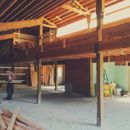Unvented vaulted ceiling insulation
Hi Martin,
I’ve read a lot about vented/unvented “cathedral” type ceilings on Green Building Adviser. Now I’m trying to really sift through the grey-area of conflicting information from all sides (my landlord, contractors, the internet, etc.!).
I have 1600 sq/ft barn just outside of Seattle with vaulted ceilings and a loft that runs through the middle (see pictures attached). The original plan was to spray foam the whole ceiling in between the jopists. However, the landlords became skeptical of this method – citing health and environmental hazards. This seemed to be a good plan because as you can see, the joists run the wrong way to easily vent the ceiling. And, I’m trying to retain the ceiling vault and height because the building is now intended to be a recording studio. I intend on using the whole building including the loft. I started reading that cut-and-cobbling between the joists with 2 inches of R-5 an inch XPS rigid foam insulation and sealing the edges *could* be a suitable vapor and climate barrier *without* venting the ceiling.
Curious what you think of cut and cobbling in my situation, spray foam, and any possible alternatives we might consider.
And for reference, I have read both:
https://www.greenbuildingadvisor.com/blogs/dept/musings/cut-and-cobble-insulation
&
https://www.greenbuildingadvisor.com/blogs/dept/musings/how-build-insulated-cathedral-ceiling
Thanks so much,
Trevor Spencer
GBA Detail Library
A collection of one thousand construction details organized by climate and house part











Replies
Trevor,
As I noted in the cut-and-cobble article, I don't recommend the cut-and-cobble approach for unvented roof assemblies, because of reports of failures. You can read about two reports of failures by checking the links in that article.
In your case, you have two choices: spray foam insulation on the underside of the roof sheathing (with or without additional air-permeable insulation under, and in direct contact with, the spray foam), or rigid foam insulation above the roof sheathing (which would require you to remove the existing roofing).
If you decide to install rigid foam insulation above the roof sheathing, there are two ways to proceed: either with 100% of the insulation above the roof sheathing, or with a combination of some rigid foam above the roof sheathing, and some air-permeable insulation directly under (and in direct contact with) the roof sheathing.
Thanks for the quick response, Martin. I figured your answer would be as such, especially with the similar case you outlined here:
https://www.greenbuildingadvisor.com/community/forum/energy-efficiency-and-durability/30344/flat-roof-insulation
It is clear to me, the spray foam is the safest way to ensure the integrity of the roof and ceiling considering my projects circumstances. However, my landlord is still weary - and understandably so considering the negative press it's received. My research and intuition tells me it is safe (with a professional and experienced contractor), and I've found most negative press to be outdated by 2-5 years at this point. Do you have an opinion on spray foam and it's "risk" factor?
Trevor
Trevor,
As I've written before, the vast majority of people who contract for a spray foam installation are satisfied with the job. The number of jobs with problems is very, very small -- a tiny percentage.
The reason that the "lingering odors" cases get so much attention is not due to frequency; its due to the fact that the consequences are serious.
Good luck with your project.